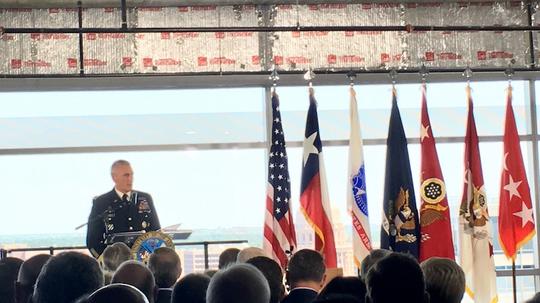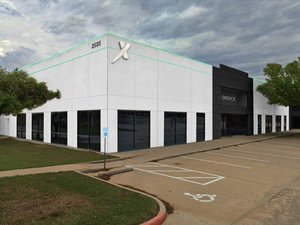
The U.S. Army's Futures Command is getting ready for the next war in an office building in downtown Austin. And one of its first big projects will be building next generation glasses that have night vision, augmented reality training capabilities and more.
The launch of Futures Command on Friday marked the first time the Army has put a big command post in the middle of a city, and it's the Army's boldest step yet in trying to reposition itself as an innovative organization with tech-enabled lethality.
For years, officials have said the Army's tech procurement and intellectual property acquisition processes have been painfully slow, which creates a security risk.
“This is an absolute necessity because of what’s happening with our competitors around the world," Sen. John Cornyn, R-Texas, said, emphasizing China's aggressive efforts to advance military tech. "They're trying to beat us at the technology game.”
While the Futures Command post is focused on modernization through technology, it doesn't sidestep the fact that it is designed to make the U.S. better at killing enemies.
“Nobody wants war,” said General Mark A. Milley. “But war is a human behavior that unfortunately has not been purged yet from humankind... And one of the ways you prevent war is by preparing for war.”
He said Futures Command is the part of the Army looking to the future – not the wars of today.
“Tomorrow could be very, very dangerous,” he said.
Cornyn, like Austin Mayor Steve Adler, has generally brushed aside questions about how the Army's weaponization of technology matches with Austin's tech and startup ecosystem and the city's generally liberal reputation.
Both political leaders, in separate comments, say the Army's expanded presence in Austin is a boon for small businesses interested in selling tech to the military or partnering with it -- as well as a fitting way for Austin to play a bigger role in national defense.
“These startups are looking for investors and what better investor could you have than the U.S. Army or the U.S. Government?" Cornyn said.
Adler told a room full of military leaders that Austin is proud to have Futures Command here, and he also noted that part of why the Army is here is because of its innovative culture. And Adler said part of that is based in Austin's weirdness, noting that Army officials might see someone riding a bike in a thong or walking down the street with brightly dyed hair.
“We support new ideas and new ways of thinking," he said.
“You have my absolute promise I’ll do everything I can to keep Austin weird, minus the bicycle and thong,” General John M. Murray, Commanding General of U.S. Army Futures Command, joked.
Under Secretary of the Army Ryan McCarthy said Austin beat out other cities by out-scoring them on an objective scale that included tech talent, innovation investment and science, engineering and math talent flowing from local universities.
He said the Army plans to integrate itself into the city's startup ecosystem, and he acknowledged that it may take some time for the Army and the startup community to feel totally comfortable with each other.
“We also need the tech community to be patient," he said. “We will have to adjust and we’ll look to the community to adjust with us.”
The Army's huge modernization effort in Austin will be led by General John M. Murray, Commanding General of U.S. Army Futures Command.
The Army describes its Futures Command as “the most significant Army reorganization effort since 1973.” It indicates the center would operate as a small and agile headquarters focused on speeding up innovations via rapid prototyping on weapons systems including missiles, combat vehicles and much more. It will create about 500 jobs -- 400 civilian and 100 military.
Friday's ceremony marked the end of a long selection process and the start of the next chapter for the Army. Here's a quick look back and where this all came from.
In April, the Army narrowed its initial list of 150 potential cities to be home of its Futures Command to 15 cities. That included Austin, Dallas and Houston in Texas. Then, in June, the Army cut its list down to five finalists: Austin, Boston, Minneapolis, Philadelphia and Raleigh, N.C.
On July 12, news broke that Austin had been selected. A few days later, it became official during a kickoff ceremony at Capital Factory.
The Army will easily be the biggest military player in Austin tech. But it's part of a new wave of military interest in Austin's innovation ecosystem.
Last month, the U.S. Air Force announced Austin would be home to its latest military innovation lab AFWERX. And that followed visits from then-Defense Secretary Ash Carter, who launched a DIUx hub at Capital Factory, and then-Army Secretary Eric Fanning, who launched the “Hack the Army” program.
As part of the launch of the Army Futures Command, military leaders poured praise on Sen. John McCain, the Arizona Republican leader who on Friday revealed he is discontinuing treatment for brain cancer.
Army Under Secretary McCarthy said the entire Futures Command effort started with a small conversation initiated by McCain.
"McCain never took an eye off of near peer competition," he said.








